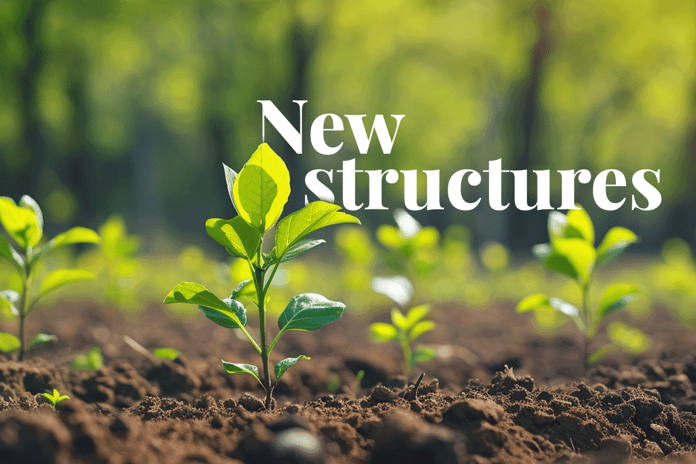In the contemporary landscape, green bonds have garnered considerable attention as a vehicle for funding initiatives with favourable environmental outcomes. Classified as a form of fixed-income security, green bonds mobilise capital for projects dedicated to environmental wellbeing, encompassing domains like reforestation, renewable energy, sustainable agriculture, and clean transportation. This blog delves into emerging structures within the realm of green finance, shedding light on innovative instruments such as green securitisations, sustainability-linked bonds, and green social bonds. These financial mechanisms not only align with the ethos of social responsibility but also stand in contrast to ordinary bonds by prioritising eco-friendly endeavours in their investment focus.
 Close-up on young tree seedlings with a forest in the background. AI generated picture.
Close-up on young tree seedlings with a forest in the background. AI generated picture.
What are green bonds?
Green bonds are a financial instrument that has gained prominence in the world of green investments, diverging from conventional bonds by earmarking proceeds exclusively for environmentally sustainable initiatives. Aligned with the overarching Sustainable Development Goals (SDGs), green bonds serve as a pivotal channel for financing environmentally beneficial projects. These bonds are issued by a diverse array of entities, ranging from governments and municipalities to corporations and financial institutions, collectively known as green bond issuers. The funds generated from these financial instruments are directed towards supporting a spectrum of environmental projects, encompassing reforestation, renewable energy initiatives, conservation efforts, and other ventures designed to mitigate environmental harm and foster sustainable development. The integration of green bonds into investment portfolios reflects a conscientious approach towards fostering positive ecological outcomes while delivering financial returns.

In addition to their instrumental role in financing sustainable projects, green bonds offer distinct advantages, particularly in nurturing and preserving nature. By directing financial resources towards initiatives like reforestation, wildlife conservation, and biodiversity enhancement, green bonds contribute tangibly to the wellbeing of ecosystems. The emphasis on nature within the green bond framework aligns with broader environmental objectives, fostering habitats for diverse species and mitigating the impacts of changing environmental conditions. Investing in green bonds not only promotes ecological harmony but also aligns with a profound commitment to the stewardship of the natural world. This dual focus on environmental sustainability and the specific benefits for nature underscores the significance of integrating green bonds into investment strategies for a more balanced and resilient planet.
Green securitisations
Green securitisations are a relatively new type of green bond structure that enables issuers to pool and sell a portfolio of green assets to investors. These securities are typically backed by a pool of assets, such as loans or receivables, that fund eco-friendly projects or assets contributing to environmental sustainability. The assets may include renewable energy projects, energy-efficient buildings, and sustainable infrastructure. The securitisation process involves packaging the assets into securities and selling them to investors in the form of bonds. The proceeds from these new bond sales are then used to finance more green projects.
One of the advantages of green securitisation is that it can provide issuers access to a wider pool of investors. By pooling and packaging the assets, issuers can create bonds with different risk profiles and maturities, appealing to a broader range of investors. Green securitisations can also help issuers to diversify their funding sources and reduce their cost of capital. Green securitisations play a crucial role in sustainable finance, allowing investors to participate in environmentally friendly projects while providing issuers with a means to raise funds for green initiatives.
Sustainability-linked bonds
Unlike traditional green bonds, sustainability-linked bonds do not necessarily finance green projects. Instead, they are linked to the issuer's sustainability performance. The bond's coupon rate is tied to the issuer's ability to meet predetermined sustainability targets, such as reducing carbon emissions, increasing renewable energy usage, or improving water management. If the issuer fails to meet the targets, the coupon rate may increase, providing an incentive to improve sustainability performance.
For issuers, sustainability-linked bonds provide more flexibility in terms of how the funds are used. Issuers can use the proceeds to finance a variety of projects, not just green ones. This can be particularly appealing for issuers with a limited pipeline of green projects or who want to address sustainability issues beyond the scope of traditional green bonds.
Green social bonds
Green social bonds finance projects with environmental and social benefits, such as affordable housing, clean water, and sustainable agriculture. These bonds enable issuers to address both environmental and social challenges with a single financing instrument.
Green social bonds have several advantages. They can help to address the social and economic inequalities that often accompany environmental problems. By financing projects that have social benefits, green social bonds can help to build more resilient and sustainable communities. Additionally, green social bonds can appeal to a wider range of investors, including those who are interested in both environmental and social issues.
DGB Group's 8% green bonds
The growing interest in sustainable finance has led to the development of new and innovative structures for green bonds. Green securitisations, sustainability-linked bonds, and green social bonds are just a few examples of these structures. These instruments enable issuers to finance a range of environmentally and socially beneficial projects while also providing investors with opportunities to support sustainable development.
As the demand for sustainable finance continues to grow, we can expect to see further innovation in the green bond market, with new structures and instruments designed to meet the needs of issuers and investors alike. DGB Group, too, embraces innovation and creates frameworks that lead us all towards building a more sustainable and resilient future. Our green bonds drive our nature-based projects forward while delivering attractive and stable returns on investment of 8% (depending on the amount invested) to our investors. When you invest in our green bonds, you invest in nature and a greener tomorrow.



